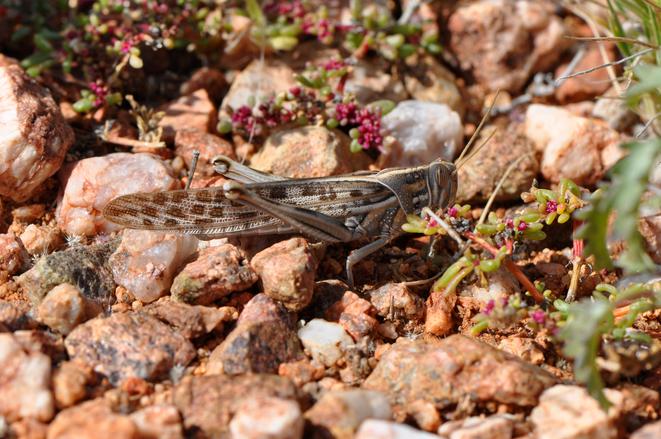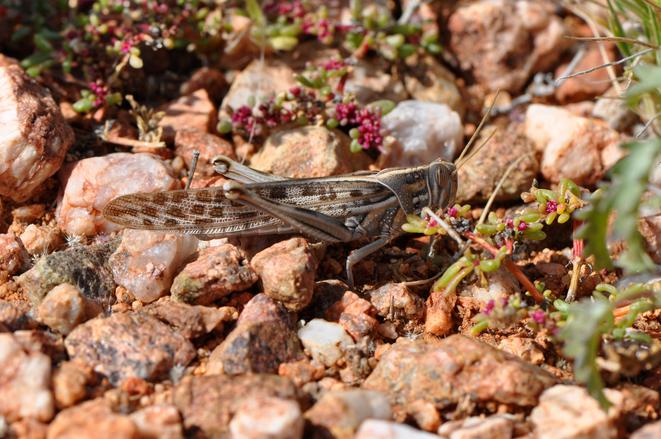
Credit: © CIRAD – A. Foucart
Desert locusts, a pest under close scrutiny
Desert locusts are a major pest on numerous crops and pastures throughout a vast area of almost 30 million km2 covering Africa north of the equator, the Near East, the Arabian Peninsula and the Indian subcontinent. Like other locusts, desert locusts can switch from a solitary phase with low population densities during recessions (periods of calm), to a gregarious phase with high population densities during invasions, when hopper bands and swarms can devastate agriculture.
The importance of the pest has necessitated the implementation of a prevention strategy led by numerous national surveillance and control centres in affected countries. In a global level, those centres are coordinated by the FAO in Rome, which has an information service in charge of monitoring the situation throughout the insect's distribution area and forecasting the risks of outbreaks and invasions. This early warning and prevention system has succeeded in reducing the extent of invasions in most agricultural areas.
A new risk in southern Africa as a result of climate change
Current and future climate change could affect the locust risk to varying degrees. It is favourable climatic conditions (heavy rain and high temperatures) that trigger invasions from more limited, desert distribution areas. It is therefore vital to assess the probable evolution of this agricultural pest so as to make the necessary adjustments to the current prevention strategy in good time. Thanks to the historical data (1930-2000) shared by the FAO Desert Locust Information Service (DLIS-FAO), a joint INRA/CIRAD team was able to study the climate niche and distribution of the species during recessions, and envisage the effects of possible climate changes between now and 2050 or 2090, in line with two future climate scenarios.
The desert locust has two sub-species, one (currently the more dangerous from an agricultural point of view) north of the equator, and the other (lesser known) in southern Africa. The research results showed that although the two sub-species occupy different climate niches in their respective recession zones, they have kept their environmental niches throughout their evolution. This niche maintenance implies that were the climate in southern Africa to become more similar to that in the North, the sub-species from the South could become as dangerous as the one from the North. Moreover, in the light of climate change, the available large-scale forecasts suggest that the southern sub-species is likely to spread.
The northern sub-species, for its part, is likely to encounter more extreme arid conditions that could shrink its overall distribution area during remissions. However, that shrinkage would primarily concern the hyper-arid heart of the Sahara and not the desert locust outbreak area, from which the first hopper bands or adult swarms start out. Another, more worrying consequence of climate change is the likely local spread on the fringes of the current geographical distribution area, such as the coastal Sahel in the South.
Keeping a watchful eye on the risks of invasions
The researchers responsible for this study concluded that the existing locust monitoring and management practices and capacities in northern Africa should be maintained, and recommended greater vigilance on the southern and northern fringes of the current distribution area. In southern Africa, the possibility of the southern sub-species becoming a greater threat to agriculture should be watched particularly closely, notably as regards its gregarization capacity under new climate conditions.
Beyond the uncertainties linked to modelling of the distribution area for a given species, the study showed that the preventive management strategy for this major pest cannot be seen to be set in stone. It must be reviewed constantly to take account not only of possible, foreseeable climate changes, but also of changes in the socioeconomic context. The CIRAD research team is continuing to work on the desert locust, in the aim of improving management of the pest by taking account of its many aspects and considering it as a complex adaptive system.
###
Media Contact
Lionel Cavicchioli
[email protected]
33-078-846-8285
Arnaud Ridel
[email protected]
33-064-244-5558
Original Source
http://www.cirad.fr/en/news/all-news-items/press-releases/2017/desert-locusts-new-risks-in-the-light-of-climate-change http://dx.doi.org/10.1111/gcb.13739





